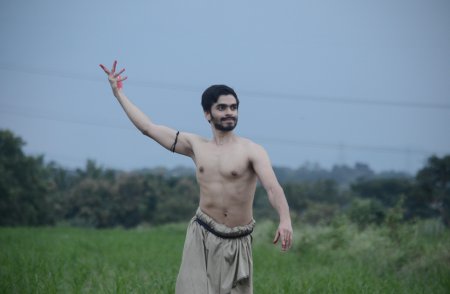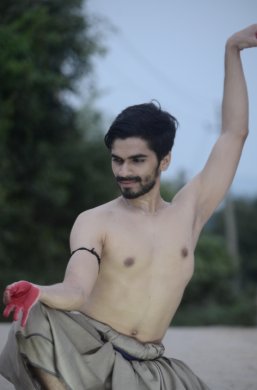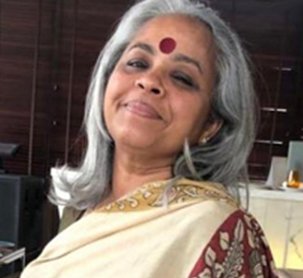
|   |

|   |
Luminescence in the horizon - Jaya Rao Dayal e-mail: jayadayal@hotmail.com November 7, 2022 I watched 'Kaali Naatakam' by Shobhit Ramesh, repeatedly over several days to try and comprehend the enigmatic nature of dance as an art. The sheer presence marked by the impactful dancer, the powerful execution of poetry brings to my mind the imageries of the power of silence. His intense articulation got me thinking about how does an artiste translate intangibles .What a difficult task it is to portray the concept of 'kaivalya'!  I got to speak with dancer Shobhit Ramesh about the process of creation and execution of the piece which is set to Malayalam poetry, by Narayana Guru, a 19th century philosopher poet. He gives credit to his parents who worked with him to getting a deeper understanding of the esotericism. The artiste has penned down a brief about the piece for viewers for whom language poses a barrier. Kaali Naatakam Her dance; Her Way With the seed sown, She nurtures creation in her womb Births it, cares for it And nourishes it with all that is needed. When it's time for it to be gone, she destroys impartially; for old must be gone for new to come. She is the universe, the universe is her. She is within us and we are within her. Truth is realised when we believe to feel it All is one and All is Her. Shobhit says the inspiration was a dance composition by Rajashree Warrier on TM Krishna's rendition of Narayana Guru's poetry. He said more than dancing the piece, the preparation lay in listening to the music. "Letting the body respond to the music (mostly), rather than logically planning one step after the other. The step before this, i.e in understanding the essence of the lines has been very essential in letting the body doing its function, of first responding to the music and then fixing what is to be done in each part". The performance strikes at different levels. Viewing dance as a process that could unlock queries and unravel thought processes. I was surprised at how a young dancer could achieve this level of maturity. The dancing body shows a complete preparedness; a certain poeticity in the inflection of movement; a range of emotions in the subtlest of form. The dancer is at one point a poet, who also has a sensibility in processing poetry; he assimilates the music. I use the word assimilate here to particularly point out to the immersion which brings out the nuances of abhinaya. This inspired me to watch a few videos of Shobhit. And my question to him was, "At what point does the body liberate itself from the bani?" This could be an extreme question but the thought behind this was that most often what one watches is a certain sense of confinement in the body. Shobhit responded, "What I am learning from my gurus Parshwanath Upadhye, Shruti Gopal and Adithya PV has been very critical in creating this piece. Their mentoring and guidance for my practice in general has affected what I create. One of their main ideas is not to restrict your style or way of dancing and expressing to one type or 'bani'. Due to this, I have been able to observe, watch, be inspired and learn from other artistes who have different takes on their practice and way of performing. This eclectic approach has helped me be flexible in my way of expression and practicing art. It has helped me choose what suits me and my body and the piece I am performing – however it is something that I am constantly working on as experience only adds to one repository of techniques to become a better artiste and to communicate effectively through dance. To this reason, I don't think I see the need to break out from a 'bani' as such, because I get the freedom to create my own style by choosing how I want to express my ideas (which includes how I want to dance my nritta as well)".  What also caught my attention was that there were a lot of stereotypical notions that were done away with. Like Devi smiling in the abhaya mudra, Kali being depicted as fierce, the bhakta always with the Anjali mudra. The lasya was indeed so contained. A certain cognitive complexity was evident in his treatment of the move from binaries to a continuum like depiction. Be it in the depiction of binaries like that of creation or destruction or masculine and feminine attributes. "...the idea of gradient and not compartmentalisation..." The conversation kept steering back to how he envisaged the Devi. What was his understanding of 'kaivalya'? Shobhit replied, "I did not make a specific effort to keep the essence of Kaivalya as something outstanding in the piece. When I thought about the whole theme and the character of Devi who is being depicted, the indifference is what came to my mind - someone who rules the whole of creation and has a grip over the continuous loop from creation to destruction, is going to be calm and poised; indifferent and impartial about what, when and how creation, preservation and destruction happens. It is this aspect towards the whole process that stood out to me more than anything; Thinking of Her this way, I believe has allowed me to capture the essence of what Kaivalya could be." An impressive performance that will remain in my mind for time to come. Thank you Narthaki, the starting point indeed was Devi Diaries. Post script: Shobhit started learning Bharatanatyam at the age of six and has been dancing for the last eighteen years. Watching this piece, I asked him if he was also trained in other dance forms or has had experience in theatre. To this, he replied that Kuchipudi was the only other dance form that he has learnt. Shobhit wishes to acknowledge the efforts and guidance of his previous gurus Prem Menon, Sadanam Rashid, Vasantha Thiruvangad and Usha Unni for recognising his ability in dance and encouraging him to take it forward in life and excel in it step by step.  Jaya Rao Dayal is trained in Bharatanatyam, and in the last decade, she has been pursuing research in Indian aesthetics. She submitted a dissertation to Jnanapravaha in Mumbai as part of a post graduate program in Indian aesthetics. |